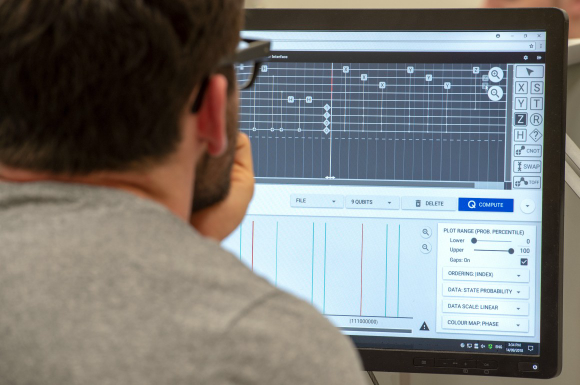New virtual quantum programming environment explains a subject even Einstein described as ‘spooky’

Quantum physicists have produced a novel system to simulate and visualise what is happening inside a quantum computer – a feat impossible to do in real life because observing the computer would ‘collapse’ its quantum state.
Quantum computers aim to address problems too challenging to be processed by regular computers, with potential applications in logistics, modelling financial data, risk analysis and the design of new materials and medicines.
There is a clear demand from students and professionals alike to learn more about the technology and become “quantum ready”.
However, a quantum computer relies on the strange rules of the quantum world of atoms and subatomic particles that even Albert Einstein described as “spooky”.
For the uninitiated, the rules of how you process numbers and compute using quantum mechanics can be quite mind boggling.
To cut through these difficulties, University of Melbourne quantum physicist Lloyd Hollenberg and his team have developed an online quantum computer simulator and programming environment – the Quantum User Interface or QUI – to enable students and professionals alike to prepare for the rapid rise of quantum computing.
“As the international race to develop quantum technology accelerates, there’s an increasingly urgent need to train the next generation of ‘quantum’ programmers, software developers and engineers,” said Professor Hollenberg, who is the Thomas Baker Chair at the University of Melbourne and Deputy Director of the Australian Research Council Centre of Excellence for Quantum Computation and Communication Technology.
“The real challenge is to get people up to speed in quantum information processing with a minimal knowledge base in quantum mechanics, and to dispel common misconceptions about how quantum computers work.
“To appreciate how different quantum information is, think about the needle in a haystack problem. A classical computer would laboriously search through every part of the haystack. A quantum computer will effectively make the needle bigger than the haystack. It’s a nice analogy, but how do you show it?”
While there is a lot of existing material to draw from – textbooks, YouTube videos, and even access to real quantum computers on-line – what is missing is hands-on experience with the concepts as you learn.
“You might think the most obvious way to provide this would be to program one of the small-scale quantum computers and simply follow how they work,” Professor Hollenberg said.
“But, a quantum computer is the ultimate black box – by the very nature of quantum mechanics, if you try to follow the flow of quantum logic on a physical machine you don’t get the full picture of what’s happening – despite all the great material available, this is a pedagogical void.”
Building on their quantum computer simulation expertise, Professor Hollenberg’s team created the QUI system to give beginners and practitioners hands-on experience, bringing the difficult concepts to life.
One of the key challenges the team faced was providing convenient visualisations of the quantum states in the quantum computer. Each time you add a qubit you double the size of the problem.
And to make matters worse, to correctly represent the underlying logic, each part of the quantum data structure state has an associated wave-like property described by a complex number.
“Anyone who tries to represent or visualise the state of the quantum computer comes up against this wicked problem – how to visualise this thing which exists in a multi-dimensional space of real and imaginary numbers, let alone the weird effects of quantum superposition and entanglement. The QUI was designed to meet this challenge while maintaining a high level of user-friendliness,” Professor Hollenberg said.
The QUI is a web-based program that lets you click and drag logic elements that operate on quantum bits (known as qubits), and create a quantum program.
A remote cluster of computers at the University runs the program on a simulated quantum computer and sends back the results in real time allowing the user to visualise the quantum computer’s state at every stage in the program.
The QUI system is now integrated into a new subject, Introduction to Quantum Computing, being run for the first time at the University of Melbourne and aimed at students from diverse areas and importantly with no quantum physics assumed.
Daniel Johnston, a University of Melbourne maths student taking the course said: “Quantum software design is such a new concept and it feels more abstract than conventional computer coding, so being able to see what is happening when we design a function really helps.”
Professor Hollenberg said: “It’s taken us nearly two years to get from the initial concept to this point where we have deployed the QUI in a teaching environment and it’s passing all the tests with flying colours. We’re also finding it’s really valuable in our research. The potential to improve the system is quite exciting – we can’t wait to finish the next version.”
The QUI development team led by Professor Hollenberg included Aidan Dang and Dr Charles Hill working on the quantum computer simulator and integration with the front-end user interface built by programmers Alex Zable and Matt Davis. IT experts Dr Melissa Makin and Dr Uli Felzmann helped develop the web-interface and user database. Research students Sam Tonetto, Gary Mooney and Greg White provided testing and feedback.
Budding quantum software programmers, or indeed anyone interested in quantum computing, can view the introduction overview video and try the system at QUIspace.org.